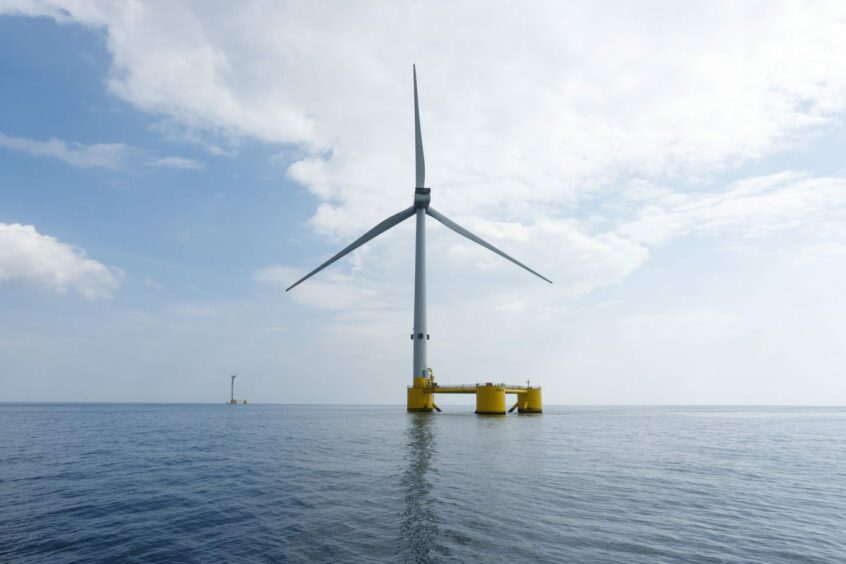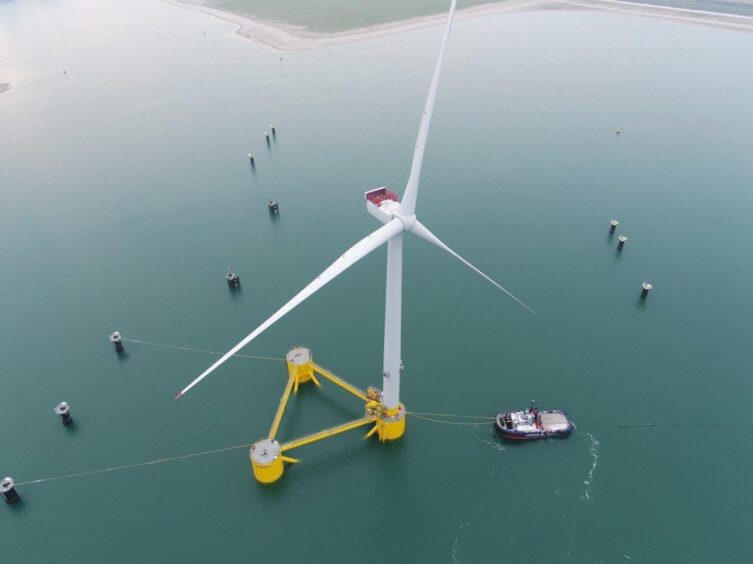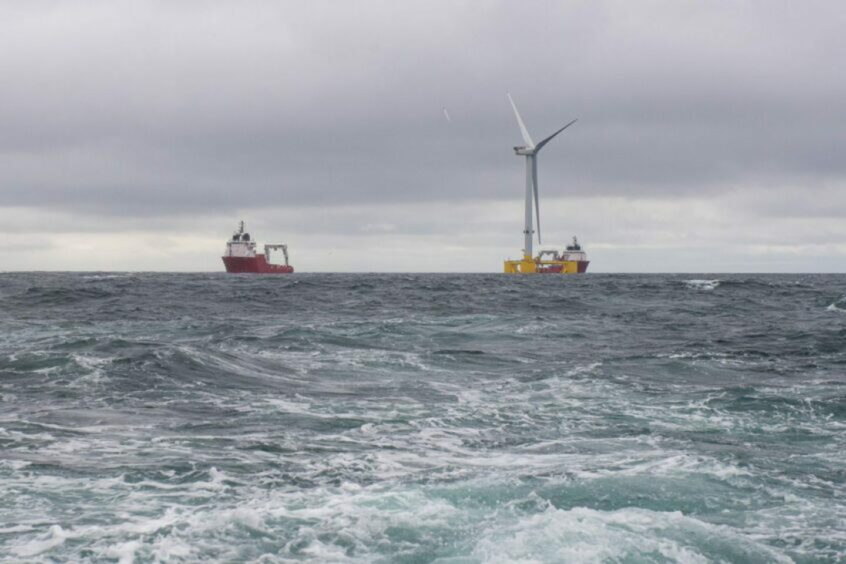
After rapidly progressing through the approval process last year, the Green Volt floating wind farm aims to start delivering the project in 2025.
Having pushed through the regulatory process and received approvals, a route to market and grid connection, Green Volt project director at Flotation Energy Matthew Green tells Energy Voice “it puts the onus back on the project to deliver”.
Green Volt, being developed by Flotation and Vargronn, will deploy up to 35 wind turbines on floating platforms off Aberdeenshire’s east coast near Peterhead.
Once completed in 2029, it will be Europe’s largest floating wind farm at 560 MW, and the first commercial-scale development to reach operations.
For the £2.5 billion project, 2024 was a landmark year. The project received its final approval in April, before securing a contract for difference (CfD) in September’s Allocation Round 6 (AR6).
The project received an offtake agreement for 400 MW at a strike price of £139.93 per MWh.
This made it the only floating wind project to secure a contract in the auction, and the first development from the Innovation and Targeted Oil and Gas (INTOG) process to win a CfD.
“The CfD win came on the back of auction concerns, not just in the UK with the previous AR5, but globally,” Green says.
“A lot of auctions were stuttering along and there was a cloud of pessimism with respect to offshore wind targets being met and fixed-bottom projects progressing against increasing inflation.”
In addition, the developers awarded two sets of front-end engineering and design (FEED) contracts for the project in late 2024.
One of the contracts went to Aker Solutions and ABB covering the topside and jacket and support for the HV voltage system, telecommunication, substation automation and hardware delivery.
The other went to Aibel and Hitachi Energy to support the conceptual design of the high-voltage system and optimising the project.
These deals signal much of the work that Green Volt’s developers will look to continue this year.
Looking to 2025
First on the agenda is the continuation of the project’s campaign of geotechnical and geophysical surveys, with contracts for the 2025 round to be awarded soon.
“The incremental, organic progression of the project is into detailed engineering and procurements,” Green says.
This includes preparing to award the main structural FEED contract this year, which covers the integration of the floating substructures and turbines.
“Hand in hand with that, just as we’ve awarded a competitive electrical FEED to two parties, that will then change to us awarding the successful electrical designer with the EPC contract for supplying all of the electrical infrastructure,” he adds.
“We will have a competitive feed, which will then become the EPC contract for the award of the substructures later in the year. We’re aiming to award the material large project contracts by the end of 2025 based on the success of the engineering, which will happen this year.”
In addition, Flotation Energy and Vargronn previously said they are in the process of searching for a turbine supplier.
While there have been rumours that the developers have chosen China’s Mingyang Smart Energy to provide the turbines, a Green Volt spokesperson told Energy Voice: “As yet, no turbine supplier has been confirmed for Green Volt. We will comply with any government regulation and guidance around security of critical national infrastructure in the selection of all our suppliers.”
The progress across 2025, reaching a mature commercial situation with the contractors and suppliers and mature engineering status will set the stage for hitting financial close in mid-2026.
“We have just started onboarding a suite of financial advisories who will help us to ensure that the engineering and procurement work streams are heading in the right direction,” Green says.
“The cost of capital is coming down. There were some pinch points relating to various uncertainties in the industry.
“That is improving across the board. We are seeing quite an appetite to get involved with a lot of significant financial institutions that would like to see their name associated with the project.”
Supply chain
For the Scottish offshore wind industry, Green Volt represents the vanguard of a new wave of projects. The ScotWind leasing round alone represents a potential 19.2 GW of floating capacity.
This is both a challenge and an opportunity for Scotland’s supply chain – a bonanza of potential contracts balanced against the task of adopting new ways of working.
“I’ve managed a number of offshore wind projects and it isn’t just dusting off the same contracts, the same methodologies and the same favoured suppliers,” Green explains. “Very little that we’re doing has been done before, to the extent that the supply chain is comfortable to do.
“It really is a collaboration with the industry and bringing it along with us,” he adds.
“Offshore floating wind is far more reliant on ports than it is large offshore construction vessels. The number of activities that we do onshore ahead of the construction phase is much greater than it is for a fixed-bottom project.”
This makes ports one of the key beneficiaries of a floating offshore wind boom in Scotland.
“What’s different from Green Volt compared to previous demonstration-scale projects is that we can’t take the risk of doing this a long way from the project site. We have to be doing it in close proximity to the project site.
“I am confident that this is going to be a good news story for Scottish ports. We will adopt a multi-port strategy for the project so we won’t be reliant upon one port.
“But we haven’t made our final decision about where we will base all of those different activities.”
Floating wind
It’s not just the supply chain that Green Volt can benefit – as the first commercial-scale project, it will help carve a path for the upcoming wave of floating projects.
“I’m conscious that there are GW-plus projects following on from the INTOG round, ScotWind, and then there will be a Celtic sea round also in the mix for the next few years. The supply chain can’t supply all those projects at the moment,” Green says.
“The costs of floating will need to be reduced significantly as we move forward, and that is purely a function of the availability of supply chain to meet their demands.”
In previous comments, Vargronn said the development could help standardise design across the floating wind sector to help projects roll out. This will help reduce costs, as the supply chain can move from creating one-off bespoke solutions toward serial production.
On top of this, regulation will need to support the industry.
“I’m confident that government regulators on a local and national scale understand that,” Green says. “While we’re creating and servicing the supply chain, they will continue to need support to move to the next level.
“There’ll be consenting challenges that we haven’t come across yet for storage of large floating structures in inshore waters – tax protocols for bringing components into territorial waters and then exporting them back out again has not been properly tested.
“All of these things make a big difference to the economics of, and deliverability of, these projects.”
In Aberdeen
For the UK and Scotland’s existing oil and gas industry, the future has long been uncertain. The energy transition comes with the understanding that fossil fuel production has an end date.
And while this is supposed to be balanced against compensatory renewable developments bringing in replacement jobs, these have been slow to materialise.
Floating wind offers a greater overlap between traditional oil and gas skills and renewables, compared to fixed-bottom offshore wind.
“The project recognises the synergies that it has with incumbent Scottish industries,” Green notes.
“It’s not just well positioned with respect to wind resources and political appetite and demand for the power, it also has a clear intent to utilise the existing oil and gas infrastructure that’s there.
“Moving from fixed to floating is really moving back to the roots of the places we’re operating in. We’re based in Aberdeen and we aim to be reliant upon companies that are based in Aberdeen.
“Green Volt has cemented that it’s becoming a project that is going to be delivered by companies with an oil and gas track record, utilising many oil and gas contractors on a decommissioned oil and gas field in the North Sea,” he adds.
“It’s gone back to its roots.”

 © Supplied by Flotation Energy
© Supplied by Flotation Energy © Supplied by Statkraft
© Supplied by Statkraft © Supplied by KATH FLANNERY / DC T
© Supplied by KATH FLANNERY / DC T